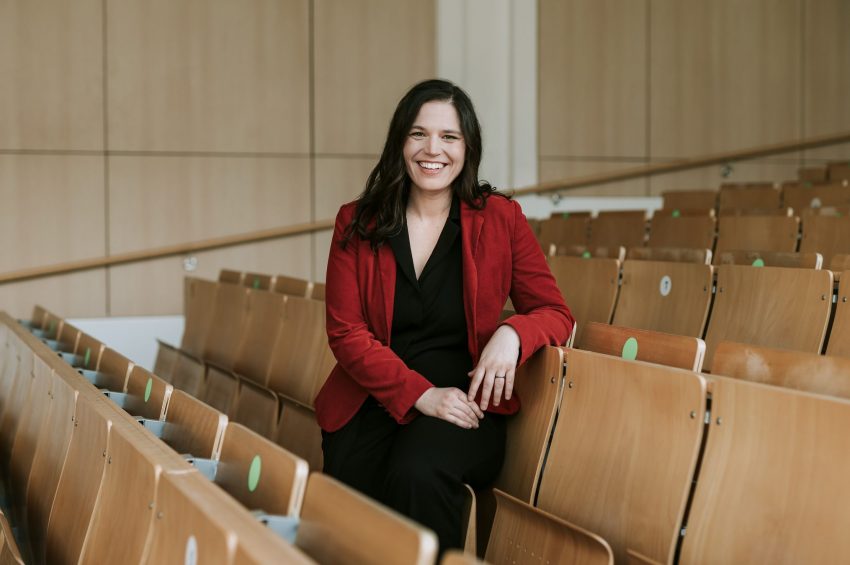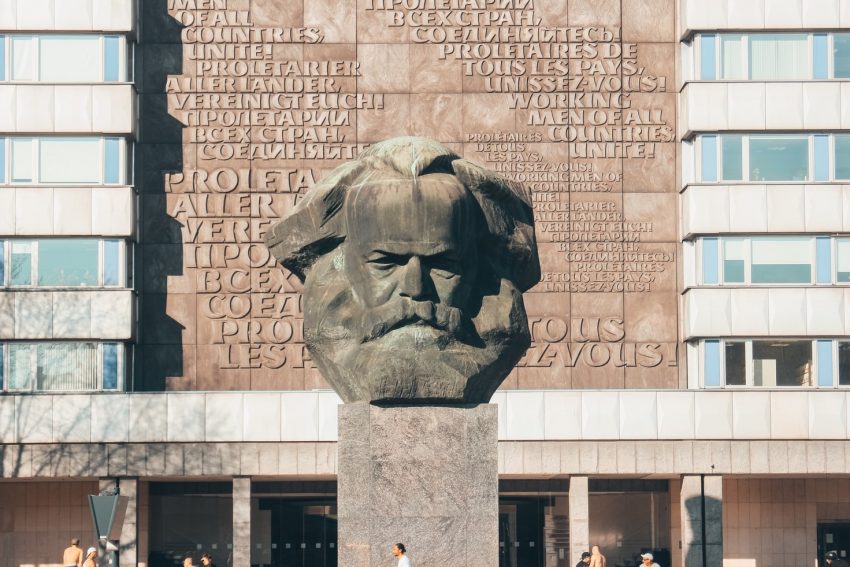How do you become a classic (sic!) and what does Twitter have to do with it? Five questions to Nicole Holzhauser about science communication and success in science
Scientific reputation is a crucial quality for scientists. How is it distributed, what does it depend on and who reaches the highest heights? In the natural sciences, it is the Nobel Prizes. In the humanities and social sciences, being assigned the status of a classic singles out a similarly exclusive group. The findings of Nobel laureates enter textbooks and form prominent bodies of knowledge that are – or at least once were – ascribed considerable importance for our scientific understanding of nature. The ideas, theories and findings of the classics are also found in textbooks, they enter the canon and become the basis for the theoretical development of the respective subject. They are worked through and their contributions form the starting point for important academic discourses and debates.
Dr. Nicole Holzhauser, postdoctoral researcher at the Institute of Sociology at TU Braunschweig, has scientifically investigated the process of canonisation of sociological classics and has chosen a quantitative methodological approach. An approach that is rather unusual in this subject area, which is characterised more by a historical perspective with a focus on case studies, and has received international attention.
Ms Holzhauser, you were asked to present your current research findings in the LSE Impact Blog. What is the LSE Impact Blog and how did it come about?
The LSE Impact Blog is a blog that aims to inform researchers, policymakers, administrators, the UK and international governments and anyone else interested in the latest socially relevant findings from the social sciences. The London School of Economics and Political Science, or LSE for short, is one of the most important social, political and economic research and teaching institutions in existence. It is world-renowned in the aforementioned academic fields. The aim of the Impact Blog – in line with the currently much discussed “Third Mission” – is to make social science research and academic debate in the aforementioned disciplines accessible to society and to increase their influence in society.
The trigger for the invitation to write a blog post was a tweet about my recent essay in the International Review of Sociology, the oldest and most traditional academic journal in the field of sociology. My essay deals with the question of which processes are important in the context of so-called canonisation, i.e. the assignment of very special importance to individual scholars, and which role social and scientific criteria for reputation play in particular. My tweet caught the attention of the editor of the LSE Impact Blog, was retweeted by him and then led to an invitation to present my research there to a wider audience.
So in this case, the use of social media has enabled you to publicise your research much more widely than might otherwise have been possible? Where do you see the importance of such newer forms of scholarly communication, beyond the classic forms of mediation through scientific essays, conference papers or the publication of monographs?
Yes, Twitter definitely increased the reach of my essay. By using Twitter and the possible snowball effect of retweeting, you already reach a much larger number of potentially interested people. Platforms such as ResearchGate also allow a certain increase in reach and the simple networking of researchers who are interested in the same topics. These types of social media, where there is (also) a strong academic user community, allow for much more effective information of colleagues than pure publication and its classic forms of announcement through publisher’s catalogues or electronically sent tables of contents of scientific journals. This can be seen not least in the fact that the most renowned scientific journals, such as Nature or Science, are committed to this.
But in my opinion, these newer channels are not only of particular importance for the “marketing” of one’s own scientific findings. Science is a genuinely international enterprise. Informal contact and communication with colleagues scattered all over the world is much easier in this way and is also possible with a completely different intensity than would be possible if one only met once or twice a year at congresses. Due to the restrictions of the past two years, new forms of communication have established themselves here. Completely new possibilities for exchange have become commonplace. Online congresses and lectures as well as video chats are now normal. In my opinion, this is of great importance, especially against the background of the ever-increasing specialisation in all sciences.
Now let’s come to your essay. What did you find out and why is it of general interest for science and, moreover, for society?
Of all the scholars who have worked academically in the social sciences, for example, only a very few – and exclusively men – have achieved the status of classics and had a lasting impact on the discipline: with ideas, theories and insights that have become canonical and entered the standard knowledge and analytical toolkit of the discipline. How this process of canonisation takes place and which factors – apart from the obvious gender aspects – are important in this process and how, has not been conclusively clarified. While there are many case studies on the individuals mentioned, quantifying approaches are rare. I have dealt with this problem using data from the 20th century and tried to analyse what makes someone become a classic. It turns out that social reputation in academia, as indicated by prominent positions such as editorships or leadership positions in academic societies, is of considerable importance for a great reputation, but is not a sufficient basis for lasting significance.
In the end, the ideas, theories and findings matter most.
Taking this further, it can be said that the development of science, which has become increasingly committed to the most efficient production of knowledge, has led to a certain rationalisation and thus also to an ongoing debate about the criteria for success for scientists and science. In the great age of classical science, the individual person and his or her academic product were still connected in a similar way as, for example, the craftsman with his or her work. Just as in the production of other goods, a kind of scientific manufactory developed in science, for example through the development of new experimental techniques that made entire series of investigations possible. In modern times, these have in turn been replaced by an industrial production of knowledge. This can be seen very clearly in the life sciences, for example. In this way, however, the previously clearly definable connection between producer and product is once again dissolved and the question of evaluating the performance of scientists working in large cooperative contexts arises in a new way. And this will possibly also raise the question of the selection of classics in the humanities and social sciences in the future.
What is success in science to you?
For me, I am successful when I have understood something better than it was understood before. In my opinion, a better theoretical understanding of the world and the chosen subject matter is the yield of science. And if I can contribute to that, then I consider that a scientific success. In a concrete example, then, I am successful if my work contributes to a better understanding of how the process of canonisation – and with it the process of “forgetting” and excluding the rest of the scientific contributions – works.
However, this determination of scientific success is not meant to devalue other types of scientific success that are more technologically oriented. Following Lewis Wolpert, one can distinguish between “science” and “technology”. And technological successes that enable new forms of influence on the world and ourselves are of paramount importance for society, even if they may not theoretically expand our understanding of the world scientifically. Of course, scientific findings that not only expand our theoretical understanding of the world – possibly fundamentally – but also enable the development of new technological approaches are of particular importance in many respects. And this explicitly includes social technological aspects.
So how do you become a classic?
It’s best if you already are one. 😉
No, seriously… The analysis has shown for the 20th century that those who became classics of sociology – in the data I examined, they were exclusively men – were those who were cited outstandingly often by their colleagues in their contemporary scientific community and who – and this also seems to be a central criterion – at the same time held very few offices, i.e. tended not to be members of the board of the scientific society or editors. This would therefore mean that as a scientist who strives for eternal status, one should concentrate on one’s own scientific activity and produce outstanding knowledge that cannot be ignored regardless of the goodwill of social contacts and networks.
One becomes a classic through ideas, theories and insights that make the world no longer look the same. And even if it may make the world seem disenchanted from time to time, in the light of the expanded understanding, the knowledge that one has recognised something significant sets in. Solving even one central or many smaller detailed problems can be accompanied by considerable scientific success – especially under the current conditions of industrial science and the associated gratification systems. In the technologically oriented sciences, solving fundamental technological problems can make one a classic. The paths to fame vary from science to science, and ultimately – and this brings us back to my research – a scientific community, in the sum of its everyday practices and rites of mutual recognition, decides who gets noticed, why and for how long.
For the many networkers and social managers in science, it may be a little disappointing that social activity and control alone can apparently temporarily exert social power and influence on scientific developments, but that this path does not really allow one to become a classic. The almost complete absence of women in the process of canonisation should nevertheless give reason to critically reflect on the criteria, some of which are social, according to which a scientific community distributes recognition (e.g. in the form of citations) in its respective presence. Leaving this aside, the positive conclusion is that lasting significance can apparently only be established through the work. And in this respect, there are actually no classics, but only particularly significant contributions to understanding the world. And that is entirely in the spirit of science.


